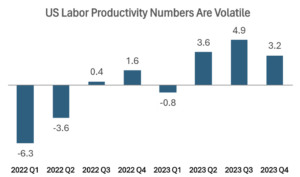
Image via Bing Image Creator
Today, we’ve released a major new report for clients on employee productivity, Increase Your Organizational Productivity Now. This report builds upon Forrester’s long history of covering productivity as a dimension of Employee Experience, driven by research from my colleague David Brodeur-Johnson. He has shown the critical role that intrinsic psychological motivation, cultivated by a positive Employee Experience, can drive employee productivity. In our new report, we expand upon that work, analyzing total labor productivity and offering a new take on how you can improve it at your organization.
Productivity Is Volatile And Often Seen As “In Crisis”
Productivity is a much watched but often misunderstood business metric applied to the workforce. Too many leaders imagine technology investments to be a silver bullet that will turbo-charge productivity, but the record is mixed:
- Slow productivity growth rate in the past two decades. Since the release of the iPhone in 2007, productivity has stalled in the U.S., growing at an anemic 1.5% annually. This rate compares poorly with the 2.7% growth rate seen from 1947 to 1973 and the 2.8% from 2001 to 2007, a period when use of the Internet likely buoyed productivity growth – but only temporarily.
- Quarterly volatility that seems counterintuitive. Economists look at labor productivity in terms of just two types of measurable inputs: How much a firm invests in capital intensity (including investments like factories, automation, or technology) and how much it invests in labor (including labor costs, hiring new employees, and investments in skills development). The problem is that many of the factors we know drive and influence productivity – like EX, leadership, culture, and collaboration – simply aren’t measured. Nevertheless, at an aggregate level, labor productivity swings in volatile fashion (as the Figure below shows). Yet we know that EX, leadership, culture, and collaboration don’t change so quickly, and often neither do investments in capital or labor.

Source: https://www.bls.gov/productivity/tables/labor-productivity-major-sectors.xlsx
Meanwhile, Leaders Are Distracted By Productivity Clichés
Too many leaders are distracted by outdated and incorrect conceptions of how to drive productivity. A couple of the clichés we discuss in our report include:
- Burnout-inducing overwork and under-staffing. Some leaders conflate productivity (which measures output per labor hour) with total outputs (which can be achieved, temporarily, by over-working employees). For example, Wayfair CEO Niraj Shah received criticism when he announced that his company is again profitable and “back to winning,” then declared that employees should work even longer hours, into the evening, “blending work and life.” We surveyed 811 workers for the report, and one of them told us about their employer’s modus operandi: “Adding more work than a person can do without feeling burnt out due to lack of staff and increase need for services.”
- Measurement madness. One problem with our data-obsessed era is that measurements can be tricky and overdone. Academics Hauser and Katz suggest that leaders too often focus on the wrong metrics, impose too many of them, and don’t understand their system-wide impacts. They write, “Many metrics seem right and are easy to measure, but have subtle, counter-productive consequences.” All these multiplying metrics can’t even be cognitively processed by employees, making it an ineffective way to change their behaviors.
The Solution: A Human-Centered, Holistic Approach
Solve for this by starting with the humanity of your employees. In our employee survey, we heard about employee practices that inhibit productivity: “[They] do not value me.” “[My employer expects me to] always exceed, not meet, goals.” “Working seven days in a row.” “Seeing a high number of patients.” “[They] give me too much work which means to fit it all in [so] the quality reduces.” “[They] expect me to do everything.” These comments are a symptom of decisions that are made above the workers themselves. You can make decisions that get you to genuine, sustainability productivity, by making decisions that recognize how:
- Human factors strongly influence productivity. Placing employees at the center of your analysis is crucial to driving productivity. We refer to the overall bucket of Employee experience, culture, employee actualization, leadership, and collaboration as human factors. Human factors can drive or inhibit the engagement of employees, which directly impacts their productivity (alongside other business benefits like creativity).
- Human factors impact capital and labor investments. Remember those favorites of economists, quantifiable investments in capital in labor? They can succeed or fail based on the human factors in your organization. But two companies could buy the same technology and earn radically different results depending on their success with human factors. For example, employees must have the skills, inclinations, and beliefs in place to successfully use automation or AI, as we’ve shown.
Speaking of AI, aren’t we on the cusp of a new era of generative AI-based productivity? I’ll be exploring this topic in two upcoming reports very soon. In the meantime, we invite clients to read our new employee productivity report, Increase Your Organizational Productivity Now.
J. P. Gownder is a vice president and principal analyst on Forrester’s Future of Work team. Clients can request a Guidance Session with him to discuss productivity, including the rise of generative AI at work (including Microsoft Copilot).








